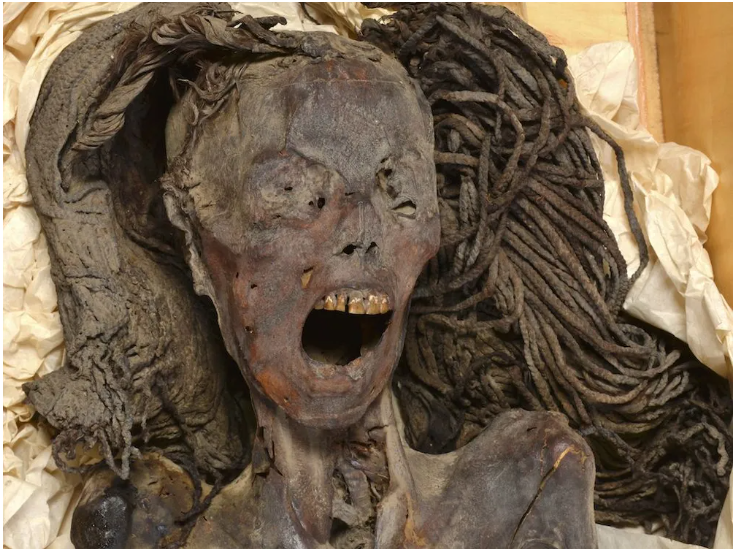Egyptian Mummy Dubbed ‘Screaming Woman’ May Have Died in Agony
In 1935, a Metropolitan Museum of New York archeological expedition working near Luxor in Egypt came across a mysterious mummy. They were excavating the tomb of Senmut, the female Pharaoh Hatchepsut’s architect and overseer of royal works when they found Senmut’s mother’s burial chamber. But the space also housed another mummy—a woman wearing a black wig, two scarab-shaped rings and a shocking and eerie screaming expression. She was called the “Screaming Woman.”
Now, almost nine decades after her discovery and 3,500 years after her passing, new research reveals interesting details about her burial. Researchers suggest that the woman may have been afflicted by a rare muscle reaction at the moment of death that immortalized her agonized expression. She may have suffered rigor mortis or cadaveric spasm, a muscular stiffening that is associated with extreme forms of stress at the time of death. Two researchers published this finding this week in the journal Frontiers in Medicine.
“We suggested that the reason [for] this opened mouth could be due to [a] painful death or emotional stress and cadaveric spasm made her face frozen to the appearance at time of death,” Sahar Saleem, co-author of the study and mummy radiologist at Kasr Al Ainy Hospital of Cairo University, tells the Guardian’s Nicola Davis. “Embalmers were unable to close the mouth and mummified the contracted body before it decomposed or relaxed, preserving her open mouth after death.”
/https://tf-cmsv2-smithsonianmag-media.s3.amazonaws.com/filer_public/92/84/9284a17b-6d82-4ec6-809d-c065444f0675/frontiers-medicine-screaming-woman-mummy-credit-sahar-saleem-01_-_copy_-_copy.jpg)
Saleem and co-author anthropologist Samia El-Merghani “virtually dissected” the Screaming Woman, who was likely a close family member of Senmut. They used techniques including CT scans, electron microscopy and X-ray diffraction to determine the woman’s approximate age, pathologies and the mummy’s state of preservation. They found that the woman would have been a little over five feet tall and had mild arthritis. She likely died when she was around 48 years old. Suprisingly the researchers found the mummy still in possession of her brain, diaphragm, heart, lungs, liver, spleen, kidneys and intestine—with no incision evident that would have been used to take them out.
“This was a surprise to me, as the classic method of mummification in the New Kingdom [circa 1550 to 1070 B.C.E.] included the removal of all organs except the heart,” Saleem tells Live Science’s Kristel Tjandra. While intact organs within a mummy are sometimes a sign of a careless burial process, the rest of the results of the virtual dissection suggest otherwise.
The woman had been mummified with rare, expensive materials. Her skin had been embalmed with juniper and frankincense. Her natural hair had been dyed with juniper and henna. And her braided date-palm fiber wig had been treated with quartz, magnetite and albite crystals. The juniper would have been imported from the Eastern Mediterranean, and the frankincense from East Africa or Southern Arabia.
“Here we show that she was embalmed with costly, imported embalming material. This, and the mummy’s well-preserved appearance, contradicts the traditional belief that a failure to remove her inner organs implied poor mummification,” Saleem says in a statement.
But in regular circumstances, embalmers would have wrapped the jaw to keep it from opening, Saleem tells Live Science. So why was the Screaming Woman, who seemed so cherished, left with her mouth gaping? Perhaps because it was impossible to close, and that’s where the rigor mortis theory comes in.
/https://tf-cmsv2-smithsonianmag-media.s3.amazonaws.com/filer_public/70/7a/707a06f5-e473-4a22-a9cf-6ceb4ebd67e2/frontiers-medicine-screaming-woman-mummy-credit-sahar-saleem-06.jpg)
“The mummy’s screaming facial expression in this study could be read as a cadaveric spasm, implying that the woman died screaming from agony or pain,” Saleem suggests in the same statement.
Randall Thompson, a cardiologist at the University of Missouri–Kansas City School of Medicine who has studied ancient mummies using CT scans and was not involved in the study, tells CNN’s Katie Hunt that the study was helpful, detailed and “made sense.”
However, because the study did not find a cause of death, it is impossible to confirm this conclusion. In fact, some researchers are skeptical. Stuart Hamilton, a forensic pathologist, tells the Guardian that he has never seen a convincing case of cadaveric spasms, and that the Screaming Woman’s mouth may have just fallen open and stayed that way.
Salima Ikram, an archeologist at the American University in Cairo, tells the Guardian that because the desiccation process during mummification takes 40 days, that should have given the embalmers time to rearrange the woman’s face.
Nevertheless, the mummy of the Screaming Woman remains “a time capsule that enabled us to know how she lived, the diseases she suffered from, and capture her death that could be in pain,” Saleem concludes to Live Science. “This type of study humanizes the mummy and let[s] us look to her as a human being.”
